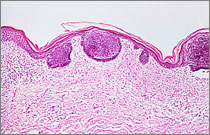Bladder cancer
| 2022 | including in situ tumours (D09.0 and D41.4) 2020 | |||
|---|---|---|---|---|
¹ per 100,000 persons, age-standardised according to the old European standard population * until 1.12.2020 ** calculated using the period method for 2019 / 2020 | ||||
| Women | Men | Women | Men | |
| Incidence | 4,682 | 12,309 | 7,540 | 23,270 |
| Age-standardised incidence rate¹ | 5.1 | 17.0 | 8.9 | 33.2 |
| Deaths 2023 | 1,945 | 4,133 | ||
| Age-standardised incidence rate¹ | 1.7 | 4.9 | ||
| 5-year prevalence* | 12,200 | 40,300 | ||
| 10-year prevalence* | 19,100 | 63,800 | ||
| Relative 5-year survival rate** | 46 % | 58 % | ||
| Relative 10-year survival rate** | 43 % | 50 % | ||
In 2022, about 17,000 people were diagnosed with invasive bladder cancer, a quarter of whom were women. In addition, about 13,680 patients were diagnosed with non-invasive papillary carcinomas (Ta) and in situ tumours (Tis) of the bladder. Poorly differentiated Ta and Tis tumours have a particularly increased risk of tumour progression and recurrence, which is also reflected in survival rates. Therefore, they have a special clinical relevance, although they are currently not classified as malignant tumours according to ICD-10. Bladder cancers are predominantly urothelial carcinomas, which often occur simultaneously at different sites of the bladder and the urinary tract.

![]() Distribution of non-invasive bladder tumours by tumour stage, grade and sex, ICD-10 D09.0 and D41.4, Germany 2015–2016
Distribution of non-invasive bladder tumours by tumour stage, grade and sex, ICD-10 D09.0 and D41.4, Germany 2015–2016

![]() Relative 5-year survival with non-invasive bladder tumours by tumour stage, grade and sex, ICD-10 D09.0 and D41.4, Germany 2015–2016
Relative 5-year survival with non-invasive bladder tumours by tumour stage, grade and sex, ICD-10 D09.0 and D41.4, Germany 2015–2016
Among men, age-standardised incidence and mortality rates have declined significantly since the end of the 1990s. This is probably the combined result of decreased tobacco consumption and reduced occupational exposure to carcinogenic substances. For women, both rates have remained largely constant, but at a much lower level than for men.

![]() Age-standardised incidence and mortality rates by sex, ICD-10 C67, Germany 1999 – 2016/2017, projection (incidence) through 2020, per 100,000 (old European standard population)
Age-standardised incidence and mortality rates by sex, ICD-10 C67, Germany 1999 – 2016/2017, projection (incidence) through 2020, per 100,000 (old European standard population)
The higher relative 5-year survival rates for men versus women correspond to a more favourable distribution of tumour stages (58 percent among men versus 46 percent among women).
Smoking influences the risk of occurrence
Active and passive smoking are the most important risk factors. Some chemical substances, such as aromatic amines, also increase risk. Known risk-increasing substances have now largely disappeared from occupational settings in Europe. However, the latency period between exposure and carcinogenesis is long, such that occupational bladder carcinomas continue to occur. Cytostatic drugs used in cancer therapy and radiotherapy involving this region of the body can increase bladder cancer risk. Other drugs, such as the antidiabetic pioglitazone, also appear to cause bladder cancer.
Furthermore, air pollution and arsenic or chlorine in drinking water increase the risk of developing bladder cancer. Chronic inflammatory damage to the bladder mucosa is an additional risk factor. Research into family clusters indicates that genetic factors may play a role in the development of bladder cancer by influencing sensitivity to carcinogens.
Date: 30.12.2024






